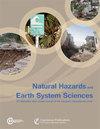Compound flood events: analysing the joint occurrence of extreme river discharge events and storm surges in northern and central Europe
IF 4.7
2区 地球科学
Q1 GEOSCIENCES, MULTIDISCIPLINARY
引用次数: 2
Abstract
Abstract. The simultaneous occurrence of extreme events gained more and more attention from scientific research in the last couple of years. Compared to the occurrence of single extreme events, co-occurring or compound extremes may substantially increase risks. To adequately address such risks, improving our understanding of compound flood events in Europe is necessary and requires reliable estimates of their probability of occurrence together with potential future changes. In this study compound flood events in northern and central Europe were studied using a Monte Carlo-based approach that avoids the use of copulas. Second, we investigate if the number of observed compound extreme events is within the expected range of 2 standard deviations of randomly occurring compound events. This includes variations of several parameters to test the stability of the identified patterns. Finally, we analyse if the observed compound extreme events had a common large-scale meteorological driver. The results of our investigation show that rivers along the west-facing coasts of Europe experienced a higher amount of compound flood events than expected by pure chance. In these regions, the vast majority of the observed compound flood events seem to be related to the cyclonic westerly general weather pattern (Großwetterlage).复合洪水事件:分析北欧和中欧极端河流流量事件和风暴潮的联合发生
摘要近几年来,极端事件的同时发生越来越受到科学研究的关注。与单一极端事件的发生相比,同时发生或复合极端事件可能会大大增加风险。为了充分应对这些风险,提高我们对欧洲复合洪水事件的理解是必要的,并且需要对其发生的概率以及未来潜在的变化进行可靠的估计。在这项研究中,使用避免使用copula的蒙特卡罗方法研究了北欧和中欧的复合洪水事件。其次,我们调查观察到的复合极端事件的数量是否在随机发生的复合事件的2个标准差的预期范围内。这包括几个参数的变化,以测试所识别的模式的稳定性。最后,我们分析了观测到的复合极端事件是否具有共同的大规模气象驱动因素。我们的调查结果表明,欧洲向西海岸的河流发生的复合洪水事件比完全偶然的预期要多。在这些地区,绝大多数观测到的复合洪水事件似乎与气旋-西风总体天气模式(Großwetterlage)有关。
本文章由计算机程序翻译,如有差异,请以英文原文为准。
求助全文
约1分钟内获得全文
求助全文
来源期刊
CiteScore
7.60
自引率
6.50%
发文量
192
审稿时长
3.8 months
期刊介绍:
Natural Hazards and Earth System Sciences (NHESS) is an interdisciplinary and international journal dedicated to the public discussion and open-access publication of high-quality studies and original research on natural hazards and their consequences. Embracing a holistic Earth system science approach, NHESS serves a wide and diverse community of research scientists, practitioners, and decision makers concerned with detection of natural hazards, monitoring and modelling, vulnerability and risk assessment, and the design and implementation of mitigation and adaptation strategies, including economical, societal, and educational aspects.

 求助内容:
求助内容: 应助结果提醒方式:
应助结果提醒方式:


